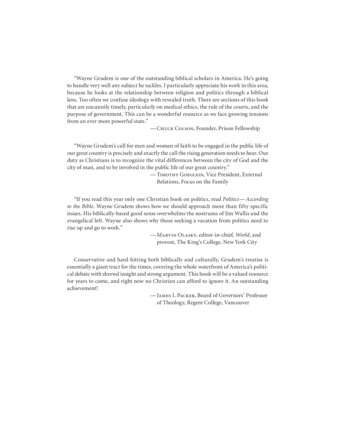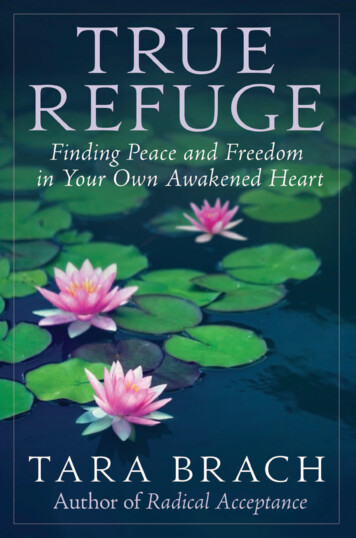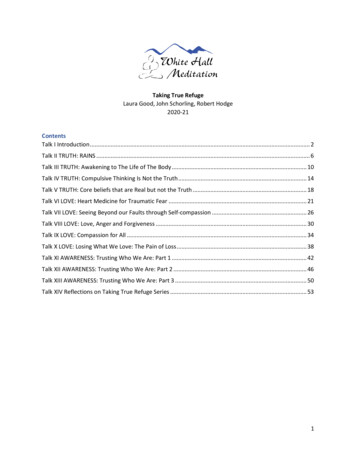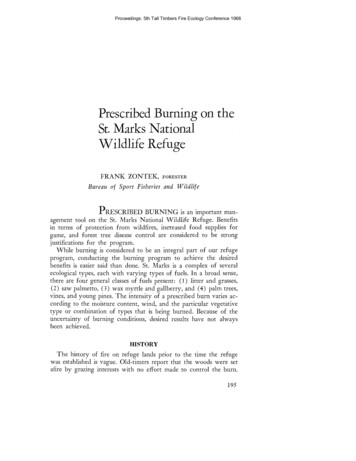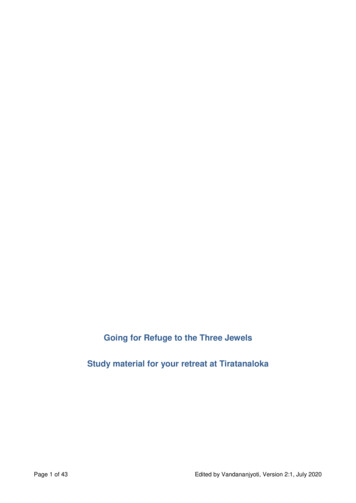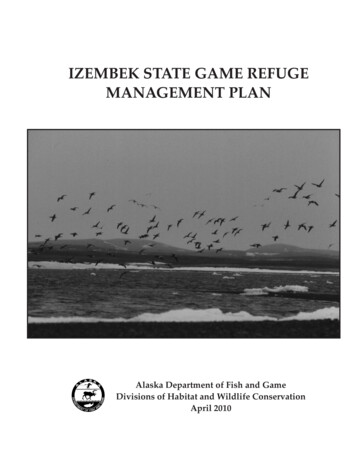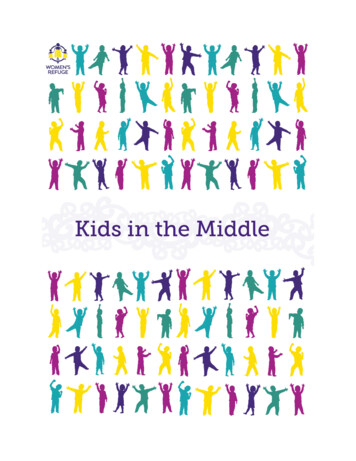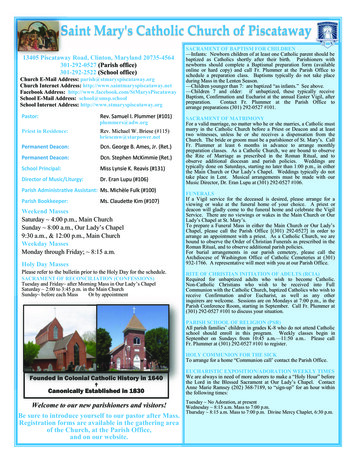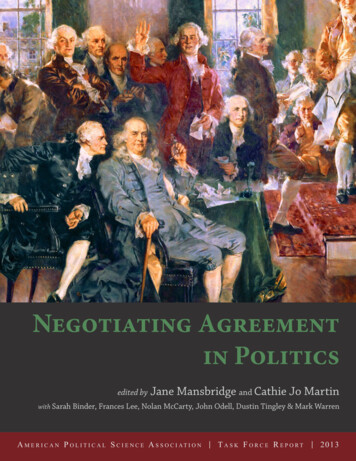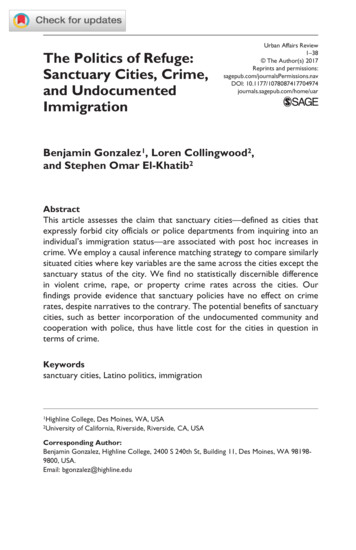
Transcription
704974Urban Affairs ReviewGonzalez et al.ArticleThe Politics of Refuge:Sanctuary Cities, Crime,and UndocumentedImmigrationUrban Affairs Review 1 –38 The Author(s) 2017Reprints and ps://doi.org/10.1177/1078087417704974DOI: uarBenjamin Gonzalez1, Loren Collingwood2,and Stephen Omar El-Khatib2AbstractThis article assesses the claim that sanctuary cities—defined as cities thatexpressly forbid city officials or police departments from inquiring into anindividual’s immigration status—are associated with post hoc increases incrime. We employ a causal inference matching strategy to compare similarlysituated cities where key variables are the same across the cities except thesanctuary status of the city. We find no statistically discernible differencein violent crime, rape, or property crime rates across the cities. Ourfindings provide evidence that sanctuary policies have no effect on crimerates, despite narratives to the contrary. The potential benefits of sanctuarycities, such as better incorporation of the undocumented community andcooperation with police, thus have little cost for the cities in question interms of crime.Keywordssanctuary cities, Latino politics, immigration1HighlineCollege, Des Moines, WA, USAof California, Riverside, Riverside, CA, USA2UniversityCorresponding Author:Benjamin Gonzalez, Highline College, 2400 S 240th St, Building 11, Des Moines, WA 981989800, USA.Email: bgonzalez@highline.edu
2Urban Affairs Review 0(0)IntroductionOn June 7, 1983, the Madison, Wisconsin, city council passed Resolution39,105, officially commending churches in the city that were offering sanctuary to Central American refugees, many (if not most) of whom had arrivedillegally. The Madison city council followed this with Resolution 41,075 onMarch 5, 1985, officially declaring the entire city a sanctuary for CentralAmericans fleeing violence in El Salvador and Guatemala. Since then, morethan a 100 cities nationwide have passed similar laws limiting the participation of local officials in the enforcement of federal immigration law, formallybecoming “sanctuary cities.” In this article, we define a sanctuary city as acity or police department that has passed a resolution or ordinance expresslyforbidding city or law enforcement officials from inquiring into immigrationstatus and/or cooperation with Immigration and Customs Enforcement (ICE).While sanctuary policies have received increasing attention over the last year,there has been little academic inquiry into this phenomenon and up untilrecently they received relatively little attention from mainstream media orpoliticians in the United States.However, on July 1, 2015, Kathryn Steinle was shot and killed in SanFrancisco by Juan Francisco Lopez-Sanchez, an undocumented immigrantwho had been convicted of seven felonies and deported seven times(Littlefield 2014). In March 2015, Lopez-Sanchez had been arrested for anoutstanding drug warrant and briefly was in jail in San Francisco where ICEfiled a detainer asking that he be released into their custody for deportation.Because of its status as a sanctuary city, the detainer was not honored andinstead Lopez-Sanchez was released, as he was not a violent criminal and thecity had declined to prosecute the marijuana-possession charge he was beingheld for (Littlefield 2014). The shooting of Steinle ignited a firestorm overSan Francisco’s sanctuary policy, with then-Republican presidential candidate Donald Trump making opposition to sanctuary policies a major part ofhis campaign in the fall of 2015. Trump had previously argued, “WhenMexico sends its people, it’s not sending their best. They’re sending peoplewho have a lot of problems . . . They’re bringing drugs. They’re bringingcrime. They’re rapists. And some, I assume, are good people.” Trump seizedon Steinle’s shooting as proof for this statement and a further justification forthe border wall his campaign had promised to build if he was elected. On theheels of Trump’s statement and the Steinle shooting, nearly all of theRepublicanpresidential candidates included opposition to sanctuary policy intheir platforms.Five days after his inauguration, Donald Trump signed an executive ordertitled “Enhancing Public Safety in the Interior of the United States,” which
Gonzalez et al.3followed through on his campaign promise to strip federal funds from sanctuary cities. The order stated that any jurisdiction that did not comply withfederal immigration policy would be ineligible to receive federal grants, andleft the designation of a “sanctuary” jurisdiction to the discretion of theSecretary of Homeland Security.1 These actions were based, according to theexecutive order, on the “ . . . immeasurable harm to the American people andto the very fabric of our Republic” that were the result of sanctuary policies.Despite providing little in way of actual evidence, President Trump has continued to cite increases in crime as a direct result of sanctuary policies, claiming in a February 5 interview with Bill O’Reilly that sanctuary cities “breedcrime.”2Yet, it remains unclear whether sanctuary policies actually lead to increasesin crime, as their opponents argue, or if they increase Latino incorporationand cooperation with police in cities like San Francisco, as their supporterscounter.3 As undocumented immigrants face deportation in addition to criminal charges, it is logical that they would avoid breaking the law to a greaterextent than the native-born population. Indeed, initial evidence suggests littlegeneralizable support for the claim that sanctuary cities cause increases incrime. In 2013, Lyons, Ve’lez, and Santoro found that those cities with sanctuary policies had lower robbery and homicide rates in neighborhoods withhigh concentrations of immigrants, suggesting that sanctuary policies areactually associated with lower crime rates. Similarly, Wong (2017) found thatwhen sanctuary and nonsanctuary counties were compared using a matchingtechnique that controlled for population size, percentage foreign-born, andpercentage Latino, counties with sanctuary policies had lower crime ratesthan similar nonsanctuary counties.While Lyons, Ve’lez, and Santoro (2013) and Wong (2017) inform ouranalyses and expectations, we employ a different analytic approach and havea different hypothesis when it comes to the effect of sanctuary cities on crime.First, we analyze the city as opposed to the Census tract or county. We areinterested in this unit of analysis because political claims and complaintsabout sanctuary cities are launched at the city level (e.g., Donald Trump andother high profile Republicans talking about San Francisco). Second,although Wong (2017) uses a similar matching strategy, he does not employmultivariate regression as we do. Finally, instead of employing a hierarchicallinear model with instrumental variables as Lyons, Ve’lez, and Santoro (2013)do—which is regression based in its orientation—we take a causal inferenceapproach that allows us to isolate the effects of the sanctuary city policyitself.4In this article, we look to build upon the findings of Lyons, Ve’lez, andSantoro (2013) and Wong (2017) by analyzing the effects of sanctuary policies
4Urban Affairs Review 0(0)on different types of crime while also matching cities based on variables likepopulation, the size of the Latino community, economic criteria, and otherracial criteria. We also argue that rather than a decrease in crime, we expect tosee no statistically significant difference between sanctuary and nonsanctuarycities. Sanctuary policies could lead to a decrease in crime, but it is unlikely tobe large enough to be statistically significant, as this would presume a large,and consistent, effect across cities. Instead, we believe it is much more likelythat sanctuary policies have no effect on crime rates.Because most studies have shown that undocumented immigrants tend tocommit less crime than the native born (Lee, Martinez, and Rosenfeld 2001;Lyons, Ve’lez, and Santoro 2013; Ousey and Kubrin 2009; Wadsworth 2010;Wong 2017), we see two possible explanations for why sanctuary cities mightresult in lower crime rates. First, the main antecedent to seeing a decrease incity crime as a function of sanctuary policy would be the movement ofundocumented immigrants into sanctuary cities post passage. If this in factwas the case, it would suggest that sanctuary cities could have lower homicide rates if there was net in-migration of undocumented citizens into a cityafter it “became” a sanctuary. We evaluate this possibility and find no difference in in-migration post passage in our data across the sanctuary/nonsanctuary conditions. Second, some sanctuary policies are premised on the idea thatthe policy will lead to greater cooperation with the police and incorporationof the existing undocumented population. The latter is expected to decreasecrime as a result of greater opportunities, as Lyons, Ve’lez, and Santoro(2013) found in their study. This is a real possibility; however, we think thisis more of a long-term possibility and unlikely to have a large enough effectto be significant, as we mentioned earlier. Any potential decrease in crimemay also be counterbalanced by an increase in crime reporting preciselybecause of increased cooperation, which is often cited as one reason to enactsanctuary policies.The other possibility—as President Trump has claimed—is that sanctuary cities by virtue of their unique status contribute to increases in crime.This claim rests on two possibilities. First—like the hypothesis anticipatingless crime—this argument might be true if undocumented immigrants docommit more crime and then move into sanctuary cities post passage. Thefirst premise does not hold because, as just stated, there does not appear tobe a significant difference in in-migration into sanctuary cities relative tosimilarly situated nonsanctuary cities. In addition, the premise does notsquare with the extant literature that undocumented immigrants commitless crime than the native-born population. Second, we might see morecrime as a result of sanctuary policy if undocumented residents already living in a city begin to commit more crime or report more crime because they
Gonzalez et al.5feel more secure. Again, this premise holds little weight as the vast majorityof research on this issue indicates that the foreign-born commit less crimethan the native born or that no difference exists (see, for example, Miles andCox, 2014, who examined the rates of homicide, rape, robbery, and aggravated assault in counties as Secure Communities was rolled out between2008 and 2012 and found no statistically significant decrease in crime ratesas a result of the implementation or intensity of Secure Communities.).5However, given the design and motivation of most sanctuary policies, it ispossible that greater cooperation between city officials and undocumentedimmigrants could emerge. This could lead to an increase in crime-reporting, not an increase in crime per se.Based on the evidence so far, we believe that a statistical examinationof sanctuary policy will show that these policies do not lead to either netincreases or decreases in crime even when cities are matched to isolate theeffect that sanctuary status has. In our analysis, we isolate the effects ofsanctuary policy itself not its antecedents—therefore, we control for thesize of the Latino population as well as the Latino noncitizen population(i.e., those most likely to be undocumented immigrants). Thus, our matching procedure allows us to compare similarly situated cities on the aforementioned variables. In this analysis, sanctuary cities—on average—willnot have more undocumented immigrants in them compared with theirmatched city, so the above logic that cities with larger shares of undocumented residents should experience lower crime rates is not applicable.6Instead, we think there should be no net effect on crime as an outcomefrom a sanctuary city policy.Most of the literature to date on sanctuary cities has largely focused on thefaith-based movements of the 1980s and 1990s on which many sanctuarypolicies were based. This article will focus on sanctuary policies post 9/11,though some of these, like San Francisco’s sanctuary policy, have roots thatcan be traced back to the faith-based movement of the 1980s. To understandsanctuary policies today, it is necessary to know a little about the movementthat many of them initially drew upon for inspiration and which enjoyed abrief rebirth on the heels of 9/11.Thus, this article proceeds as follows: First, we define what we mean by asanctuary city. Next, we trace the origins of sanctuary cities in the UnitedStates. This is followed by a critique of the supposed link between criminalityand immigration. We then place these cities into contemporary political context and lay out the claims as to why they are bad or good policy. This leadsto a set of hypotheses that we then test in the rest of the article. We review ourdata and methods employed to answer the questions posed. Finally, we present our results and finish with a discussion of these results.
6Urban Affairs Review 0(0)Defining the Sanctuary CityOne initial difficulty inherent in the study of sanctuary cities is that there isno concrete definition of how exactly to define what a sanctuary city is. Forinstance, the Ohio Jobs & Justice PAC, which maintains a list of sanctuarycities online, also includes “informal” sanctuary cities in their definition.Informal sanctuary cities are where there is no resolution or policy on paperbut instead where their classification is based on observed actions, such aslack of enforcement.7 However, this classification seems open to subjective,and biased, interpretations of who is illegal and what counts as lack ofenforcement.For those cities with formal policies in place, there is a gradation of sanctuary policies. Some cities or police departments only forbid law enforcement from making immigration inquiries,8 while others forbid local officialsfrom doing so in the dispensation of city-level benefits. Some jurisdictions,like San Francisco, take this a step further by refusing to honor detainers byICE for nonviolent offenders. Some cities also include direct ideologicalstatements affirming the rights of immigrants or criticisms of federal immigration enforcement and policy. For example, Berkeley’s Resolution 63,711N.S. states, “Whereas, the spirit and intent of Berkeley’s refuge Resolutionswould be violated if City funds, facilities or staff were utilized to assist theFederal government’s inhumane immigration policies and practices.”9 In cities like Berkeley, sanctuary is declared not just for practical reasons but alsoas a way of protesting federal immigration policies. Yet not all policies thatcould be construed as “sanctuary” policies include this ideological aspect orhave as their goal protecting the rights of immigrants themselves. As previously stated, we define a sanctuary city as a city or police department thathas passed a resolution or ordinance expressly forbidding city or law enforcement officials from inquiring into immigration status and/or cooperation withICE, thus incorporating both ideological and nonideological cities for thepurpose of this analysis. In future work, we may return to this to see if thereare identifiable differences in effect between the two different “types” ofsanctuary cities.A number of scholars have recently begun an examination of subfederalimmigration policies like Arizona’s SB1070, which would have allowedpolice to ask for proof of citizenship during routine traffic stops (Gulasekaramand Ramakrishnan 2015; Newton 2012; Ramakrishnan and Gulasekaram2012; Vasanyi et al. 2012). In addition, scholars have examined the expansionof local enforcement and cooperation (e.g., see Capps et al. 2011), as well asthe process of integration (Mollenkopf and Pastor 2016). Related to the normative implications of some of this research, sanctuary policies can be
Gonzalez et al.7thought of as the “other side of the coin” to policies like Arizona’s SB1070.Subfederal immigration policies like SB1070 have often rested on claims thatthe federal government is not doing enough, which therefore justifies state orlocal intervention in immigration policy, leading to what Vasanyi et al. (2012)call a “multilayered jurisdictional patchwork.” While sanctuary policies reston the opposite claim that the federal government is being far too aggressivewith immigration enforcement for justification, they also represent a subfederal level of policy making when it comes to immigration (Gulasekaram2009). Similarly, they also face some of the same critiques that can be leveledat policies like SB1070, particularly to charges that they are driven by ideological considerations rather than negative effects on local immigrant communities or police departments from participation in the enforcement offederal immigration policy (Gulasekaram and Karthick Ramakrishnan 2015;Ramakrishnan and Gulasekaram 2012). Yet, it is unclear if sanctuary policieshave negative effects that could justify their repeal, while other subfederalpolicies like SB1070 have been shown to have very real negative impacts interms of the potential for racial profiling and trust between the Latino community and local officials (Waslin 2010).The Birth and Growth of Sanctuary CitiesTo gain an intuition for why sanctuary policies might actually promoteincorporation as opposed to crime, it is important to understand their birthand development. The Central American Sanctuary Movement of the 1980sis the ideological precursor to modern sanctuary policy and was motivatedby the deportation of those fleeing political violence in El Salvador andGuatemala. The Central American Sanctuary Movement would provide safeharbor to many of these immigrants via a network of churches and synagogues spread across the nation, despite the potential consequences of thisopen defiance of U.S. immigration policy through the blatant harboring ofundocumented immigrants. The Sanctuary Movement encompassed a number of religious and faith-based groups around the country, with additionalsupport coming from university campuses, civil rights organizations, lawyers, and a host of other concerned parties (Golden and MacConnell 1986).The Sanctuary Movement grew into a nationwide phenomenon, and itsmembers did not shy from the public eye despite the illegality of theiractions. Rose Cruz Villazor cites some astounding figures in relation to thenumber of individuals involved with the Sanctuary Movement. She notes,“At the height of the sanctuary movement, an estimated 20,000 to 30,000church members and more than 100 churches and synagogues participatedin the sanctuary movement, making the conflict between the church and
8Urban Affairs Review 0(0)state inevitable” (Villazor 2008, 141). In addition, the movement had tremendous public support according to Villazor, including governmental support from 47 members of Congress.This was followed by the New Sanctuary Movement that came into existence following the September 11 attacks and the passage of the Patriot Act.The New Sanctuary Movement drew on Central American SanctuaryMovement for inspiration for its resistance to more aggressive immigrationenforcement on the part of ICE that often led to the separation of families(Freeland 2010). Both were founded by church and faith-based groups andsought to address what was perceived to be inequities in the enforcement ofU.S. immigration policy. Most sanctuary policies were based on the intentions behind these faith-based interventions on behalf of undocumentedimmigrants and refugees though some, like Los Angeles’s Special Order 40which was passed in 1979, were based simply on fostering greater cooperation with authorities on the part of the Latino community.The U.S. Patriot Act, the Clear Law Enforcement for Criminal AlienRemoval (CLEAR) Act, and the Homeland Security and Enhancement(HSEA) Act that came on the heels of September 11 led many cities to adoptsanctuary policies in response to what they believed were the abuses inherentin this legislation and the burden it imposed on local law enforcement by having them enforce federal immigration law. While these policies were basedon the sanctuary legislation passed during the Central American refugee crisis in the 1980s, they differed significantly in the group they were meant toprotect. While refugees fleeing political violence elicited some sympathy,modern sanctuary cities protected an oft-demonized group: undocumentedimmigrants. It is those cities who passed sanctuary policies in the wake of9/11 that this article will focus on because of their place in the larger debateabout undocumented immigration. With nearly 12 million undocumentedimmigrants currently in the United States and a regular scapegoating of thisgroup as job-stealing criminals who refuse to assimilate (and speak English)the existence of sanctuary cities is argued to drive up crime, increase unemployment rates, and encourage further undocumented immigration.Besides having passed sanctuary ordinances, sanctuary cities vary fromone another on many socioeconomic variables—including population size,noncitizen Latino population, partisanship, and poverty levels. Forinstance, two sanctuary cities Gaston, Oregon, and New York City, NewYork, vary considerably. Gaston is about 45 minutes (by car) outside ofPortland and is essentially a farming community. In the year 2000, Gastonhad just 600 people; whereas New York City recorded over eight millionpeople and is the cultural and financial capital of the United States. As of2000, the percentage of the population that was noncitizen Latino in New
Gonzalez et al.9York was roughly 7% but the overall Latino percentage was about 21%. InGaston, the percentage of noncitizen Latinos was about 4% with a totalLatino population of about 15%. Likewise, the areas vary on partisanship;in the 2000 election, Gaston resided in a swing county (50% of WashingtonCounty voted in favor of Republican George W. Bush), whereas New Yorkwent over 74% for Democrat Al Gore. Thus, not all sanctuary cities aresimply liberal enclaves with large noncitizen populations. Finally, Censusrecords indicate that 1999 poverty levels for individuals 18 years and olderin Gaston was 5.9%, and over 18.4% in New York. Clearly, sanctuary cities are not uniform.Despite sharing sanctuary status, each of these cities passed slightly different ordinances at slightly different times. According to the NationalImmigration Law Center (NILC), in April 2002, Gaston’s City CouncilResolution No. 03-01 made “detecting or apprehending persons of foreigncitizenship based only on violation of federal immigration law” illegal forcity employees and departments.10 Similarly, while New York City long hadsanctuary policies favorable to undocumented immigrants, the city reassertedits support for sanctuaries with Executive Order 41. Passed in August 2003,the order “prohibits city officers or employees from disclosing confidentialinformation, including information concerning immigration status” in all butthe most extreme situations where the individual is either wanted for nonimmigration crimes or is a known terrorist.11The Myth of Immigrant Criminality and SanctuaryPolicyThe idea that sanctuary policies drive up crime rates is premised to a largeextent on the notion that undocumented immigrants tend to offend at higherrates, something that has been disproven time and again. In fact, many studiesfind an inverse relationship between immigration, undocumented or otherwise, and crime rates. One of the earliest examples of this was the 1931 reportby the Wickersham Commission on crime and the foreign born, which specially examined the relationship between Mexican immigration and crime.The commission found that the native born offended at higher rates in mostinstances than did Mexican immigrants (National Commission on LawObservance and Enforcement 1931). Even in those cities where Mexicanswere found to offend at higher rates than the native born, the offense wasoften cultural rather than criminal. Indeed, many of the arrests were for violations of Prohibition laws, which makes sense as alcohol consumption waslegal in Mexico at the time.
10Urban Affairs Review 0(0)Despite these findings by the Wickersham Commission, criminalizationhas been the default response of the federal government to the “problem” ofundocumented immigration. In 1929, undocumented entry was formallymade a criminal offense, with illegal entry deemed a misdemeanor and reentry after deportation a felony under Senate bill 5094. Its passage helped todefine how the federal government would respond to undocumented entry inthe decades to come by linking the long-standing rhetoric of immigrant criminality to the formal legal treatment of the undocumented for the first time(Gonzalez O’Brien 2018). The 1996 Illegal Immigrant Reform and ImmigrantResponsibility Act (IIRIRA) furthered these linkages by increasing the militarization of the southern border and focusing on crime-control tactics as theprimary response to undocumented immigration, which would only be exacerbated on the heels of September 11. This program of criminalization hashelped to turn Latino immigrants into a racialized threat, justifying more andmore extreme measures to control them, leading to programs like DonaldTrump’s proposed border wall with Mexico and, in the eyes of some, justifying his comments about Mexican immigrants (Provine and Doty 2011).Criminalization has proven to be ineffective at actually reducing undocumented immigration, but like “broken windows” policing, it is a popularresponse because its failure can simply be sold as a result of a need for greaterenforcement and militarization. If a triple fence is not working, for instance,build a wall; if deportation is not dissuading people from entering unlawfully,threaten to charge them as criminals.While criminalization has largely been the default federal response, studies have found no support for the idea that immigrants are responsible formore crime. In 2001, Lee, Martinez, and Rosenfeld (2001) examined homicide rates in three border cities with large immigrant communities and highlevels of immigration between 1985 and 1995. Examining 352 neighborhoodcensus tracts in Miami, El Paso, and San Diego, the authors found that thepercentage of new immigrants in these tracts had no relationship to homiciderates, with the exception of El Paso, where there was an inverse relationshipbetween the two. Rather than immigration, the only consistent predictor ofhomicide in the three cities was, unsurprisingly, poverty. In a longitudinalstudy of homicides in San Diego from 1980 to 2000, Martinez, Stowell, andLee (2010) found that neighborhood homicide rates in San Diego were, aswas the case in El Paso, negatively associated with the percentage of foreignborn who were present in the community. In 2010, Tim Wadsworth expandedon these studies by drawing on homicide and robbery data for 459 citiesnationwide and using a pooled cross-sectional time series model, whichallowed him to examine the effect that changes in immigration had on crimerates between 1990 and 2000. Wadsworth (2010) found that the size of the
Gonzalez et al.11new immigrant population, defined as those who had been in the UnitedStates five years or less, had an inverse relationship to rates of both robberyand homicide.Indeed, if anything, undocumented immigrants may be more likely to bevictims of crime, rather than perpetrators of crime (Kittrie 2006). This isbecause, regardless of legal formalities, many undocumented immigrantsmay fear that turning to local police will result in deportation. For example,undocumented women have been shown to be reluctant to call the police incases of domestic violence due to fear that either they or their partner will bedeported (Crenshaw 1995; Menjivar and Bejarano 2004; Menjivar andSalcido 2002). In addition, the immigrant population—especially the undocumented—may experience cultural and language problems interacting withthe state, leading some to remain in the shadows as victims (Davis and Erez1998). Indeed, research shows that non-Hispanic Whites are less likely thanAnglos, Blacks, American Indians, and Asians to report violent crime perpetrated against them (Rennison 2007).These studies suggest that immigrants tend to offend at lower rates thanthe native-born population, which we would expect to apply to the undocumented community as well. Sanctuary policies could help with incorporation,which Lyons et al. argue could lead to lower crime rates in sanctuary cities.However, the positive benefits associated with greater Latino incorporationcould be hidden insofar as crime rate is concerned, as cooperation could leadto a concomitant rise in crime reporting—regardless of actual changes tocrime levels. Moreover, the data suggest that an increase in the size of theimmigrant population in a city should decrease crime even if incorporation isnot assisted by sanctuary policies. Because the presence of immigrants seemsto be positively related to lower crime rates, we would expect that unlesssanctuary cities draw in a larger number of immigrants, there would be norelationship between sanctuary policies and crime. As mentioned earlier, wedid evaluate the in-migration in both sanctuary and nonsanctuary cities in ourstudy and did not find a significant difference. As sanctuary policies do notseem to increase the number of immigrants in a city, we would expect themto have little effect on the crime rate.However, the record on sanctuary cities remains very unclear. Althoughthere are a number of blogs and websites such as that maintained by the OhioJobs & Justice PAC
less crime—this argument might be true if undocumented immigrants do commit more crime and then move into sanctuary cities post passage. The first premise does not hold because, as just stated, there does not appear to be a significant difference in in-migration into sanctuary cities relative to similarly situated nonsanctuary cities.
